The 600-mile (965 km) stretch of the Loire River valley and its tributaries make up one of France’s top wine regions. Get to know the wines (from Muscadet to Sancerre) in this Loire Valley Wine Guide.
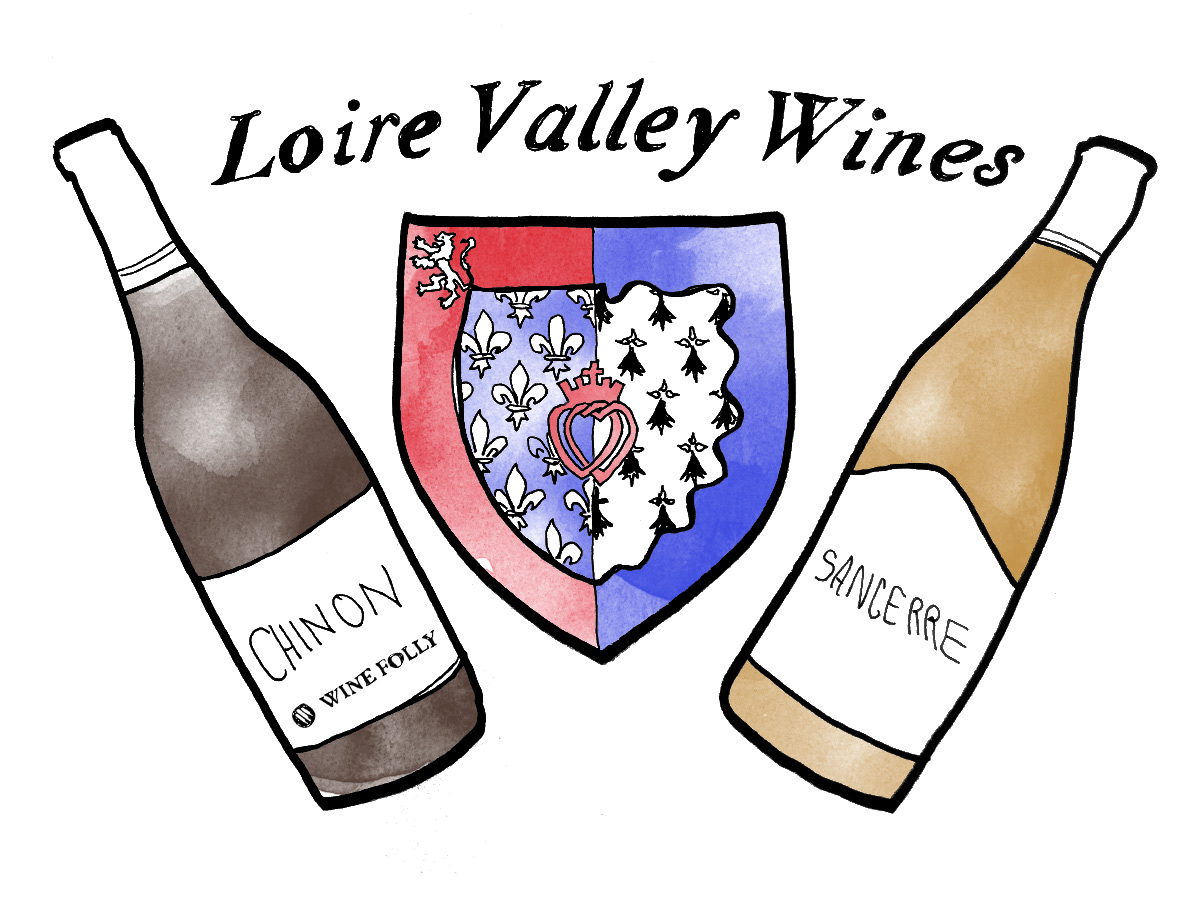
Explore this diverse region’s grapes, wine appellations, history, culture, and climate. In truth, the Loire Valley feels quite varied from the foothills of the Massif Central to the hip Port city of Nantes. And, as you might imagine, the wines vary, too!
- Explore the many subregions of the Loire and learn their wine specialties.
- Understand how terrain and climate affect wines from each of the four major subregions.
- Get a peek into the ethos that drives current Loire wine trends.
- See what’s exciting in Loire Valley wines and try them for yourself!

Loire Valley Wine Regions
- Lower Loire: A maritime region called Pays Nantais (“Nantes Country”).
- Middle Loire: The vineyards in Anjou, Saumur, and Touraine (the “Garden of France”).
- Centre Loire: The Centre-Loire vineyards, including Sancerre, which flanks Burgundy.
- Upper Loire: Containing Auvergne and surrounding vineyards.
The Major Grapes
The classification systems in the Loire Valley dictate what grapes are planted there. Of course, many winegrowers are adopting practices to optimize vineyard growth and longevity, molding the Loire’s landscape today. Still, a few major grapes dominate the vineyards.
Chenin Blanc
Most famously known in Savennières, Anjou, Saumur, Touraine, Vouvray, Montlouis, and Jasnières.
Light- to full-bodied, the tension of Chenin, coupled with its juicy and tannic structure, makes it hard to resist. Chenin, also known as Plant d’Anjou, is the Loire’s darling because of its versatility. Made in every style (dry, sweet, and sparkling), it also pairs with almost every food because of its high level of acidity.
Expect aromas of soft-baked golden apples, with undertones of quince, dried flowers, and beeswax, with an element of crisp minerality. For the experienced taster, wet wool is a blind giveaway of Chenin, and when grapes are affected by botrytis, expect a honeyed ginger note.
Cabernet Franc
Most famously known in Chinon, Saumur-Champigny, and Bourgueil.
Cabernet Franc ranges as expansively as Chenin. It runs the gamut from light- to medium-bodied with a fresh tang of acidity. The savory character of Cabernet Franc pushes forward, along with red fruits, pencil shavings, and cedar notes.
Cabernet Franc, also known as “Breton” in the Loire, has origins in anywhere from Bordeaux to the Spanish Basque Country. In any case, it has southwesterly origins. This cool-climate-loving grape is at its happiest growing on limestone soils.
Sauvignon Blanc
Most famously known in Sancerre and Pouilly-Fumé.
If the Loire were on Instagram, its biggest Sauvignon Blanc “influencer” would be Sancerre. It’s the global benchmark for this grape, perhaps because it’s native to the eastern Loire. Generally, Sauvignon Blanc thrives in the cool continental climate of Centre-Loire.
Expect green apple and mirabelle plum flavors with herbal and floral undertones that stand well against its sometimes flinty and sometimes smoky minerality.
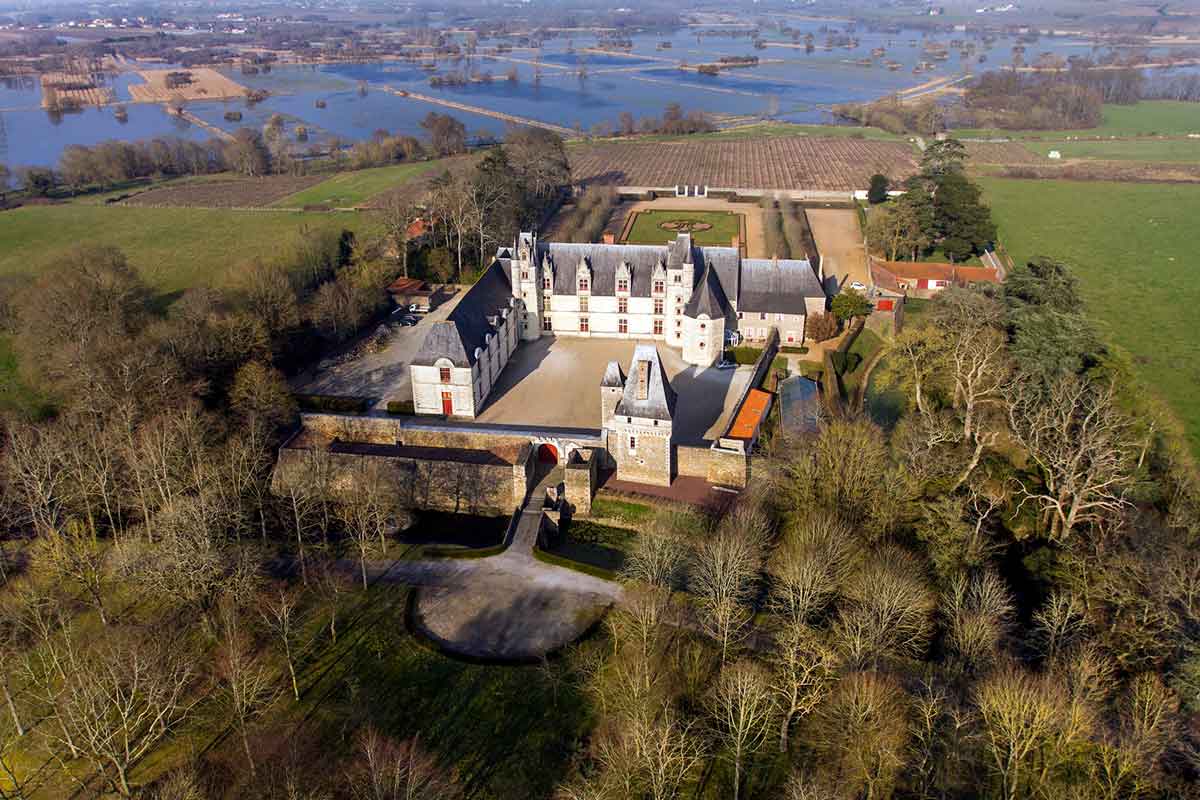
Melon de Bourgogne
Most famously known in Muscadet Sèvre et Maine.
Have you ever smelled the sea in your wine glass? Melon de Bourgogne, or just “Melon,” exudes the sea-like qualities of its maritime vineyards in Pays Nantais, where it’s commonly known as “Muscadet,” which is the name of the region where it grows. The briny citrus minerality on an often fattened-up or creamy lees-aged frame lends itself to a quaffable “glou-glou” experience.
The grape is rebirth as drinkers gravitate toward subtler, saline-driven wines.
Gamay
Most famously known in Saint-Pourçain, Côtes du Forez, Côtes d’Auvergne, and Côtes Roannaise.
Hailing from Bourgogne and the primary grape of Beaujolais, Gamay has a strong presence in the Loire and rightfully so. Growing conditions in the cooler eastern section, coupled with the granitic soils of the Loire, resemble that of Beaujolais. Gamay is one of the light-bodied reds (similar to Pinot Noir) with gentle tannins, a vivid presence of acidity, and floral fruity notes.
Others to Know
- Romorantin: This grape grows only in the minuscule appellation of Cour-Cheverny in Touraine. Think dry Chenin with honey undertones. If you see a bottle of this, don’t hesitate!
- Chasselas: An easy-drinking varietal that surprises you with a friendly balance of subtle fruit and chalky minerality.
- Grolleau Noir: An acid-forward Loire native who packs less of a punch and is well known as a blender with others, especially reds, rosés, and sparklings.
- Pineau d’Aunis: A blending grape whose spicy yet mineral red fruit personality has a passionate following in the Loir Valley (not misspelled, “Loir” is a tributary!), specifically Coteaux du Vendômois and Coteaux du Loir.

Lower Loire Pays Nantais Vineyards
The Pays Nantais is all about white wines – the bracing, citrusy, sea-spray-in-your-face type of white wines – that scream for fresh oysters. This is white wine country.
The Terrain: The majority of the vineyards are found on the flat, south-facing banks of the Loire, Sèvre, and Maine Rivers. The Atlantic Ocean is very close, from 6–60 miles (10–96 km) to the west, so the climate is maritime with cold, damp, stormy winters, cool, cloudy springs, warm, humid summers, and often blustery falls. (Sounding a bit like Seattle, Washington!)
The Soils: Pays Nantais vines grow upon Massif Armorican schist, mica schist, gneiss (metamorphic granite), granite sands, gabbro (intrusive igneous rock), amphibolite bedrock with sandy, stony soils and are predominantly on the left bank of the Loire. These soils are well-drained, which is important for vines to survive in this wet climate.
By the way, grapes grown on well-drained, rocky, sandy soils tend to produce wines with high minerality, lighter-than-average body, and bolder aromatics.

Wine Varieties
- Melon de Bourgogne (Muscadet): Not related to the Muscat family, although it is a distant cousin of Chardonnay! It was originally brought from Burgundy to replant after a frost in 1709, which killed a great number of Loire vineyards.
- Folle Blanche: Used in wines labeled with the “Gros Plant du Pays Nantais” appellation.
- Pinot Gris: Used in Coteaux d’Ancenis Malvoisie, a sweet white wine.
Lower Loire Appellations
Muscadet AOP
The largest appellation (in terms of sheer size) in the Loire Valley contains several more focused regions. Wines labeled with Muscadet AOP are all crafted from Melon and best enjoyed young and fresh. Muscadet AOP wines are lean, minerally, and lacking fruit – save for subtle pink grapefruit pith and white pepper notes.
All Muscadet region wines (save for Malvoisie – a sweet wine of Pinot Gris) age from 6 to 24 months on their lees (sur lie), to give them a rounder and more supple mouth feel. To age a wine on the lees is to refrain from filtering the wine after fermentation and stir up the dead yeast particles as the wine rests. Wines taste creamier, and often show more of the yeasty, secondary aromas of cheese or beer.
Muscadet Sèvre-et-Maine AOP
This region sits just southeast of Nantes and is thought to be one of the best appellations for Melon. The area has both sub-appellations and something called Cru Communaux or “communal crus” – growing zones that aren’t yet official appellations.
- Muscadet Sèvre-et-Maine Clisson AOP: An official appellation with granitic gravel soils, which lend rich wines with dried fruit notes. Wines are required to age 24–36 months on the lees.
- Muscadet Sèvre-et-Maine Gorges AOP: Official appellation with clay, quartz, and gabbro (chunky volcanic rocks) with wines noted for minerality and smoky notes. They age anywhere from 24 to 40 months to fully develop.
- Muscadet Sèvre-et-Maine le Pallet AOP: An official appellation with gneiss and gabbro soils. These are lean wines that age for 18 months on the lees.
- Goulaine: A Cru Communal named after the significant chateau in the area. Wines offer rich, ripe fruit notes and age on the lees for 20–30 months.
- Château-Thébaud: Cru Communaux with wines that have green fennel and anise aromas as well as salinity on the palate. Wines must age for a long time on the lees, from 36 to 48 months.
- Mouzillon-Tillières: A Cru Communal with tightly-wound Melon wines with noticeable bitterness.
- Monnières-Saint Fiacre: Cru Communaux that produces Melon with floral notes and subtle waxy character.
- La Haye-Fouassière: A Cru Communal with very pebbly soils and wines with notable aromatics leaning towards menthol. Wines age for at least 18 months.
- Vallet: Cru Communaux producing lean and floral wines which age at least 18 months on the lees.
- Champtoceaux: A Cru Communal which is technically within Muscadet Côteaux de la Loire. Wines offer more fruit and age for at least 17 months on the lees.
Muscadet Coteaux de la Loire AOP
This is in the same area as Côteaux d’Ancenis AOP, but this official appellation covers all the Melon-based dry wines in the region, which are known to have flinty notes.
Muscadet Côtes de Grandlieu AOP
A low region that’s closest to the ocean. Wines are made of Melon and are very light, perfumed, dry, and lean.
Coteaux d’Ancenis AOP
The only red and rosé appellation found this close to the coast. The reds use Gamay and Cabernet Franc and taste lean and floral. The surprise here is a tiny amount of Pinot Gris (here, they call it “Malvoisie”), which is made in a lightly sweet style.
Off-Beat: Fiefs Vendéens AOP
South of Nantes and close to the ocean, a few small parcels make up Fiefs Vendéens AOP. It’s an adventure out of Loire Valley wine proper. Look for refreshing dry whites made from Chenin Blanc, Sauvignon Blanc, Chardonnay, and Melon, plus off-dry rosé and lighter reds of Gamay, Pinot Noir, Cabernet Franc, and Grolleau.
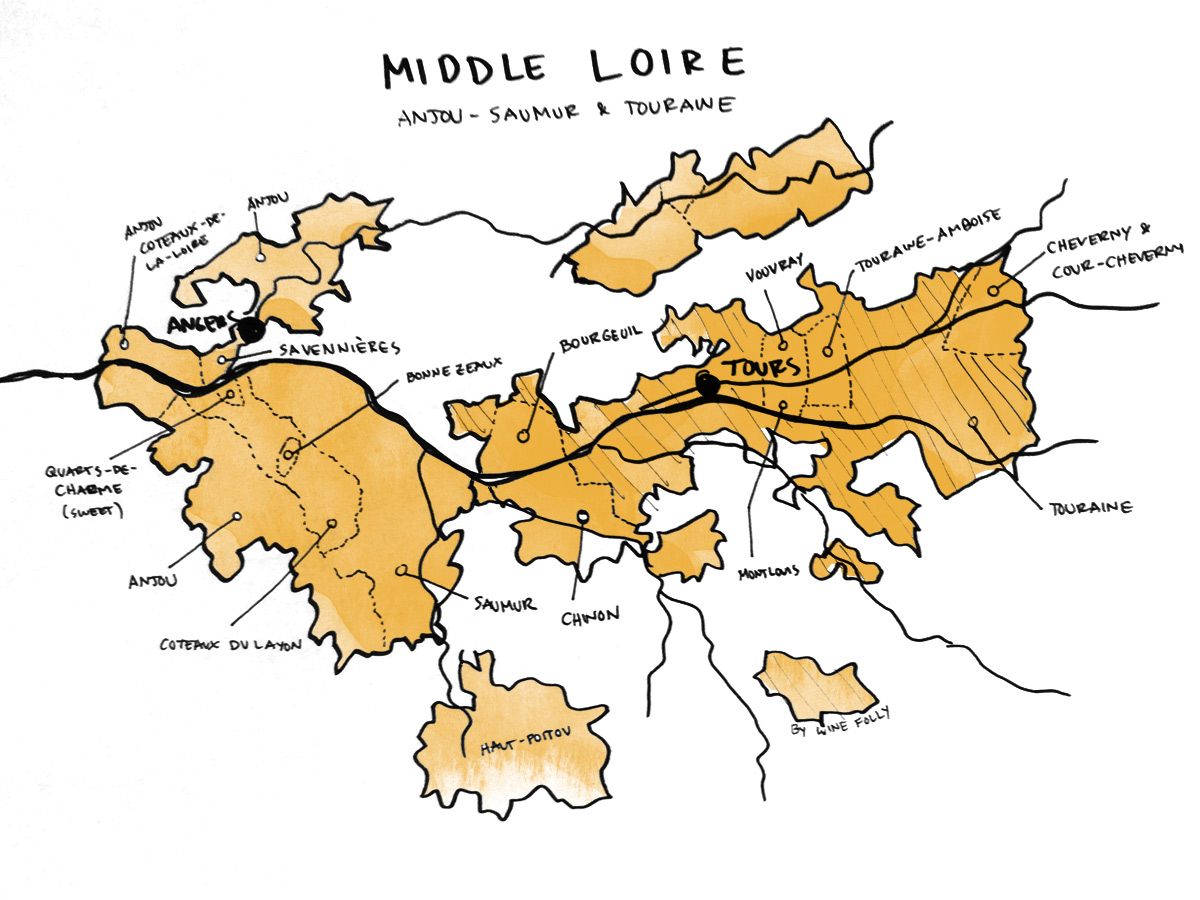
Middle Loire Anjou, Saumur & Touraine
The vineyards surrounding the towns of Angers and Tours lie in some of the most elegantly breathtaking scenery in all of France. This is where Chenin Blanc reaches its zenith (as in mind-bendingly great), where sparkling wines rule, and where Cabernet Franc takes center stage.
The Terrain: The maritime weather is tempered as you move inland. The seasons and climate here feel more defined and hospitable. This particular part of the Loire is relatively flat and is one of the warmest in the entire Loire Valley.
The Soils: There are a myriad of soils within the five sub-regions of the Middle Loire:
- Anjou: Western spots show dark schist soils referred to as “Anjou Noir,” which result in more powerful, structured wines. It’s impossible to dig, so the cellars are above ground. The eastern part shows oyster-flecked limestone known as “tuffeau blanc.” This stuff crumbles easily, so there are lots of cellars that are great for sparkling winemaking.
- Saumur: In the center of Anjou and Saumur lies the Layon river. It’s some of the best climate conditions in the world for “noble rot” (morning fog, Chenin Blanc, dry “foehn” winds) and thus Loire’s first Grand Cru sweet wine: Quarts de Chaume finds itself here.
- Touraine: Touraine is located upon the Paris Basin and thus full of limestone (aka “Turonian tuffeau”) topped with flinty clay (“perruches”) or sand and gravel. Each of these soil types imparts levels of “puissance,” structure and age-ability. Tuffeau is the noblest, followed by perruches and finally, gravel.
- Orleans: Limestone “tuffeau” with clay, sand, and gravel.
- Loire Valley: More limestone “tuffeau” with clay, sand, and gravel.
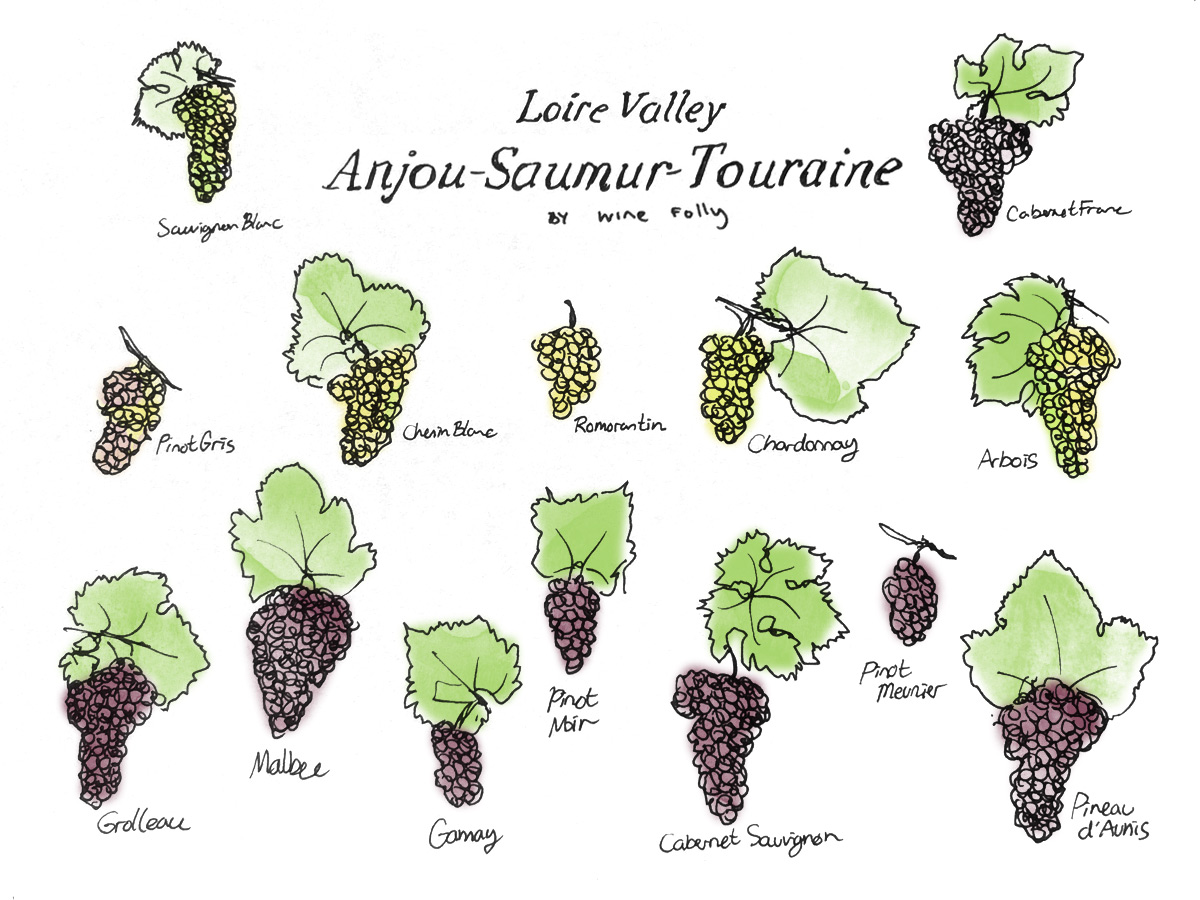
Wine Varieties
- Chenin Blanc: Sometimes referred to as “Pineau de la Loire.”
- Cabernet Franc: Originating likely in the Basque region, it’s called “Breton” in the Loire.
- Others: Romorantin, Arbois (rare indigenous white grape), Sauvignon Blanc, Pinot Gris, Chardonnay (mostly unoaked), Cabernet Sauvignon, Pineau d’Aunis (rare indigenous red grape), Malbec (aka “Côt”), Gamay, Grolleau Noir (a red), Pinot Noir, and Pinot Meunier.
Anjou Wine Appellations
If Anjou were known for just one wine style, it would be rosé. Rosé accounts for half of the region’s production. Here are the leading appellations for rosé used in Anjou:
Anjou Rosé
- Rosé de Loire AOP: A dry rosé that typically uses Cabernet Franc and Grolleau with ripe red fruit aromas and a lean, zippy taste. This appellation can use grapes from all over the Loire.
- Rosé d’Anjou AOP: A just off-dry style (barely sweet) with intensely fruity notes of strawberry, rose petals, and subtle spiciness of black pepper.
- Cabernet d’Anjou AOP: A rosé using just Cabernet Franc and Cabernet Sauvignon made in an off-dry style with candied fruit aromas of strawberry and red currant.
Anjou Red and White Wines
The Anjou region also produces some red and white wines:
- Anjou Blanc AOP: A secret value spot for both dry and off-dry Chenin Blanc!
- Anjou Rouge AOP: Simple, earthy red wines of Cabernet Sauvignon or Cabernet Franc.
- Anjou Villages AOP/Anjou Villages-Brissac AOP: The best parcels inside Anjou of Cabernet Franc and Cabernet Sauvignon.
- Anjou Gamay AOP: An appellation specifically for Gamay making fresh and juicy red wines.
Future Loire Grand Cru for Dry Chenin Blanc? Savennières
Savennières is a unique Chenin Blanc area that has been vying for Grand Cru status for some time now. Any. Day. The region is unique in that the vineyards have traditionally been passed from mother to daughter. There are three Savennières appellations:
- Savennières AOP: Planted on five steep south-facing hills. Some consider this to be the best dry Chenin in the world. White lime flowers, anise, grapefruit, and beeswax.
- Savennières-Roche-aux-Moines AOP: Just seven producers here on a steep schist slope, which is hand-harvested.
- Coulée de Serrant AOP: This historic (12th century!), renowned monopoly (single producer region–Nicolas Joly) and France’s only 100% biodynamic AOP. Dry, age-worthy Chenin that is harvested later than most other appellations in the region.
Anjou-Layon Sweet Wines
Sweet wines have historic repute in many of the Anjou appellations. All are crafted from Chenin Blanc and influenced by Botrytis cinerea or “noble rot” lending a rich, honeyed, and nutty nuance to these sweet nectars.
- Anjou-Coteaux de la Loire AOP: Similar soil to Savennières with a lighter concentration of sweetness than other AOPs on the Layon.
- Bonnezeaux AOP: Exceptional noble rot Chenin Blanc wines that are comparable to Quarts de Chaume.
- Coteaux du Layon AOP: Sometimes labeled with a village name as well.
- Coteaux de L’Aubance AOP: Lighter and more airy style of sweet wines when compared to those of Bonnezeaux and Quarts de Chaume.
- Quarts de Chaume AOP: A “Grand Cru.” Wines must have a minimum of 85 g/l or 8.5% residual sugar (a little less than the sweetness of Coca-Cola) but usually have much more than that!
Anjou Sparkling Wines
Whites of Chenin Blanc with aromas of nectarines and honeysuckle. Rosé bubbles include Cabernet Franc and Cabernet Sauvignon with hints of fresh-picked raspberries.
- Anjou Mousseux AOP: Aka “Anjou Fines Bulles”, a predominantly white traditional sparkling method that covers wines from the areas of Anjou Blanc, Anjou Rouge, Cabernet d’Anjou, and Rosé d’Anjou.
- Crémant de Loire AOP: This production area covers most of the Middle Loire. “Crémant” means producers use the traditional method and are considered more serious than that of Anjou Mousseux.
Saumur Wine Appellations
Around the town of Saumur is the heart of Crémant de Loire sparkling wine production. Vineyards planted on limestone soils give the grapes the bright acidity they need to make outstanding sparkling wines. Under the vineyards lie miles and miles of tunnels and caves carved from the limestone – the perfect place to age these delicious, bright bubbles.
- Coteaux-de-Saumur AOP: 100% Chenin Blanc, which is hand-harvested to produce vibrant wines. Mostly known as a sweet wine, although both sweet and dry styles exist.
- Saumur Blanc AOP: Made into both still and sparkling styles. Vineyards are Turonian tuffeau (white chalky limestone).
- Saumur Mousseux AOP: The lightly sparkling appellation in the area.
- Saumur Rosé AOP: This region was formerly Cabernet de Saumur. Wines smell aromatic and taste mostly dry, coming from sandy-clay soils.
- Saumur Rouge AOP: Originally, Cabernet Franc was meant to be used in Saumur Brut sparkling wines, but this appellation has proven to make dry reds as well.
- Saumur-Champigny AOP A region that’s mostly Cabernet Franc since the 1800s planted on sandy-chalky soils.
- Saumur Puy-Notre-Dame AOP The highest elevation of all Saumur appellations and considered a golden child of Saumur’s red wines.
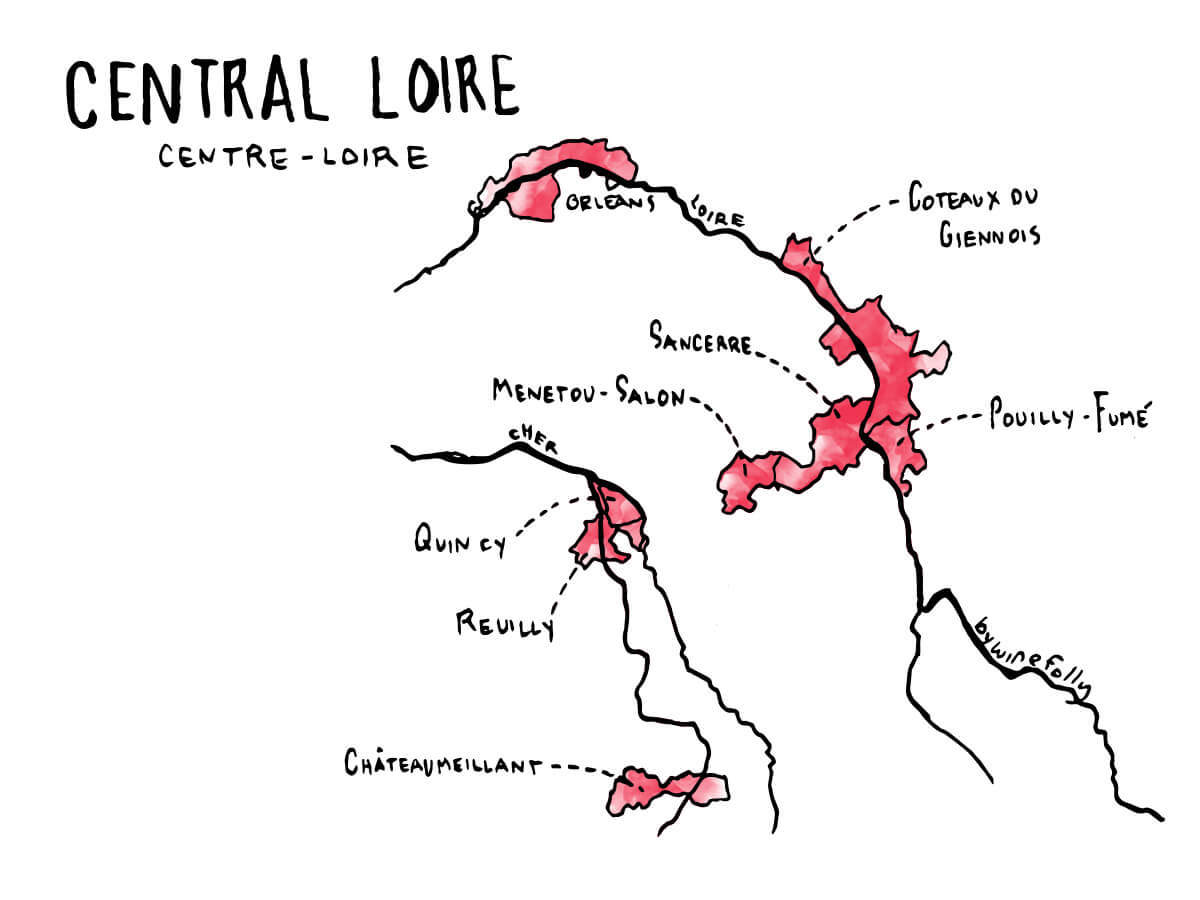
Central Loire Centre-Loire Vineyards
Home to the most recognizable wine region in the Loire Valley, Sancerre is known for its benchmark Sauvignon Blanc. The Centre-Loire surrounds the exact center point of France! Since this area is geographically closer to the Burgundy wine region (known for Pinot Noir and Chardonnay), you’ll see some overlap here.
The Terrain: Situated between three rivers – Loire, Cher, and Indre – this far-eastern region is continental (warm, balmy summers and cold, snowy winters) with very little Atlantic Ocean influence.
The Soils: Part of the Paris Basin, Centre-Loire has chalky limestone subsoils consistent with the ancient seas that were once located there, as evidenced by fossilized oyster shells you find beneath the vines.
- Terres blanches (aka Kimmeridgian): Marl (clay) limestone that is slow to warm. This lends to richness and texture in wines.
- Caillottes (Portlandian limestone): Aka “Oxfordian” limestone, which is stony and quick to warm, resulting in lean, early-maturing wines with vibrant notes of stone fruit.
- Silex (Flint): Rocky with flint and clay, this soil is slow to warm and gives white wines a reductive character (smells like smoke and gunflint) to pretty flowers and minerality when the wines open up!
- Sables (Sands): Well-draining soils that make lightly-colored, fruity red and rosé wines.
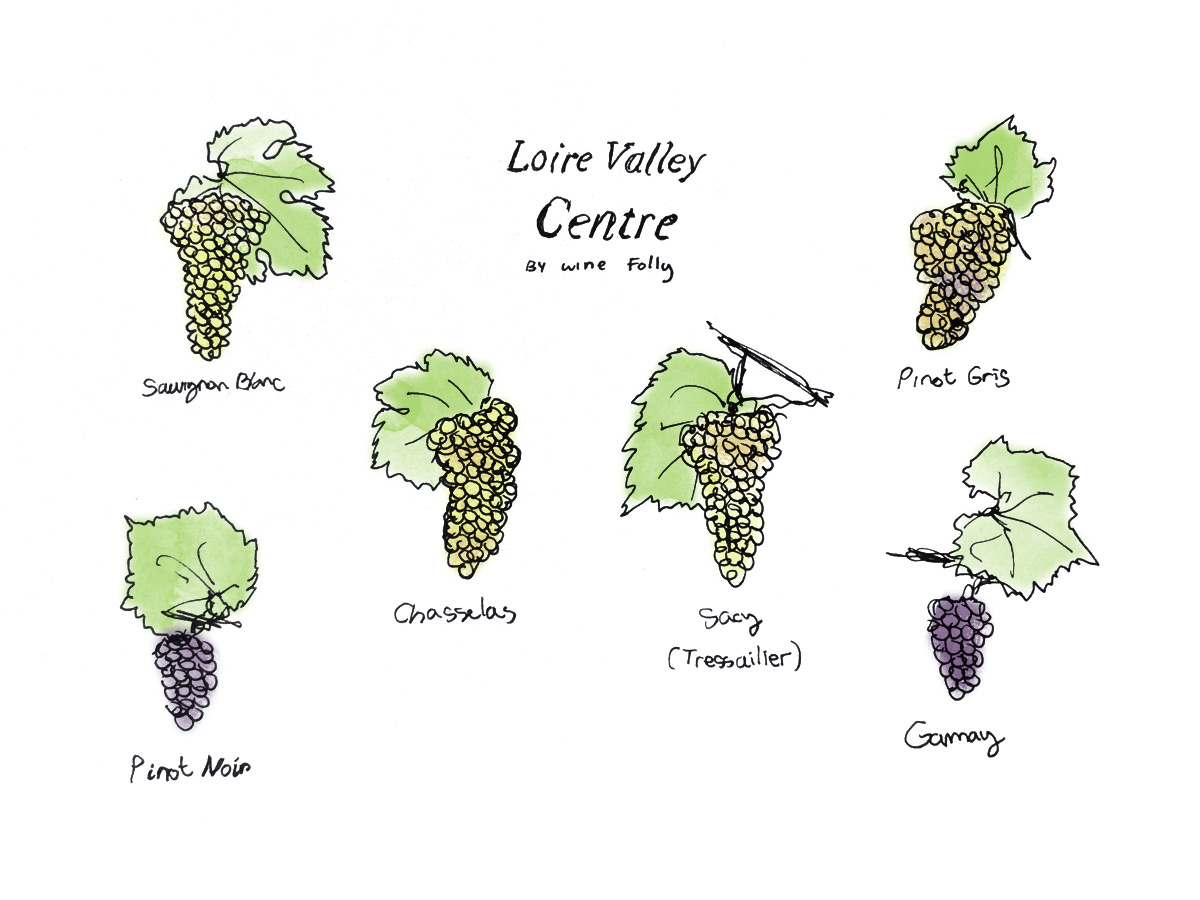
Wine Varieties
- Sauvignon Blanc: Arguably the most important variety in this region that is emulated worldwide.
- Pinot Noir: Due to the proximity and influence of Burgundy, Pinot Noir is increasingly important here.
- Chasselas: A rare, Swiss native that pops up in bottlings from the tiny Pouilly-sur-Loire appellation.
- Others: Pinot Gris, Sauvignon Gris, and Gamay.
Centre-Loire Appellations
- Sancerre AOP: With centuries-old repute, this appellation has long defined Sauvignon Blanc. Originally planted entirely with Chasselas until the phylloxera pandemic impact shifted the focus to exclusively Sauvignon Blanc for white wines in 1931. Pinot Noir also makes an appearance in both red and rosé from Sancerre – vibrant acidity, tart cherries, and earthy-styled Pinot.
- Pouilly-Fumé AOP: (Aka Blanc Fumé de Pouilly) has a nearly identical soil profile to Sancerre, with some of the most distinctive notes of gunflint and smoke (fumé) in the area.
- Pouilly-sur-Loire AOP: The only appellation in the Loire where you will find Chasselas, an underrated variety with subtle notes of fresh daisies and dried apricot.
- Quincy AOP: One of the most historic AOPs in the Loire as the very first Loire region to be named AOC in 1936. (making it the second oldest AOC in France behind Châteauneuf-du-Pape!) Its east-facing plateau of chalk grows exclusively white grapes (Sauvignon Blanc with some Sauvignon Gris).
- Reuilly AOP: One of the driest areas of the Centre, this AOP produces a range of refreshing Sauvignon Blanc, Pinot Gris, and peppery Pinot Noir on limestone south-southeast facing slopes.
- Menetou-Salon AOP: Sancerre’s “cheaper twin,” or “sister.” (Take your pick.) Flatter terrain of Kimmeridgian limestone (that white chalky stuff) beneath brown clay-rich marl produces whites with a bit of menthol, aromatic floral and silky reds and cotton-candy pink rosé wines.
- Coteaux du Giennois AOP: Kimmeridgian limestone with some flint (rocks) produces bright, lean, minerally whites of Sauvignon Blanc and red/rosé wines from Pinot Noir and Gamay.
- Châteaumeillant AOP: Surprise surprise! This appellation is mostly Gamay (~75%) with a bit of Pinot Noir and Pinot Gris. Expect ripe, juicy wines with a touch of that Gamay bitter-green tannin.

Upper Loire “Auvergne” Vineyards
The oft-overlooked fourth sub-region of the Loire, the Upper Loire or “Auvergne,” and its hefty historical relevance in France (a 14th-century rival of Beaune!) is one with immense potential. These appellations are very much worth experiencing… if you can track them down!
The Terrain: Considered the most obscure region of the Loire at its most southernmost point (which is the actual geographic center of France!) with slopes predominantly western facing and a climate that ranges between warm(ish) Rhône Valley temps (such as Côtes du Forez) and high altitude extremes.
The Soils: Located atop over 500 extinct volcanoes and granitic soils of the Massif Central. Chalky clay, terraces of sand and gravel and rocks of granite and gneiss make up the subsoils of the Upper Loire.
Wine Varieties
- Gamay: If you are a lover of Beaujolais, you will adore these. Of Burgundian origin.
- Sacy (Tressalier–a rare white): Brings “vivacity.”
- Pinot Noir: “Auvergnat” means Pinot Noir… subsequently this variety grows VERY well here.
- Others: Chardonnay and Sauvignon Blanc.
Upper Loire Appellations
- Saint-Pourçain AOP: Also known as “Limagne” (the name of the plain/plateau where it’s located), these wines are blends of Chardonnay/Sacy for whites and the Gamay/Pinot Noir are reminiscent of Burgundy. Vineyards exist on a single slope of alluvial terraces, chalky clay, and granite/gneiss, schist soils. Varied is the name of the game.
- Côtes d’Auvergne AOP: This was once one of the highest-producing regions in France (19th century) and located on the same latitude as Saint-Émilion, Côte-Rôtie, Piemonte, and the Willamette Valley (the 45th parallel!). This exciting region has diverse hilly soils of clay, basalt, marl, granite, gneiss, and sedimentary ash grows Gamay, Pinot Noir, and Chardonnay.
- Côtes du Forez AOP: These southernmost vineyards of the Loire date back to the 1st century CE. Protected south/southeast-facing foothills of basalt and granite slopes. The region has only nine growers!
- Côte Roannaise AOP: 100% Gamay (red and rosé), half of which are farmed organically and made via semi or full carbonic maceration for tutti-frutti “quaffable” wines or traditional fermentation for a little more structure. Multi-colored quartz (pink, red, and white) with red clay mix.
Last Word on the Loire
Over the centuries, the Loire has been the embodiment of splendor, extravagance, opulence, gastronomy, and nobility, with vineyards as veins snaking through the breathtaking landscape. To know the Loire is to understand that you are still only scratching the surface. The further you go, the more you realize the Loire is a constant shift. Here are a few that are very much worth trying if you have the chance:
- Briny Melon wines in Muscadet and lightning-bolt Anjou Blanc Chenin Blanc.
- Layered age-worthy black schist Anjou Noir, Chenin Blanc, and heady, sharp-tongued, pencil-sharpened Touraine Cabernet Franc.
- World-famous Sancerre and unsung hero Auvergne.
Indulge the impulse and dive deep into this intriguing region. Just be forewarned; the Loire is to be experienced and never fully known.
